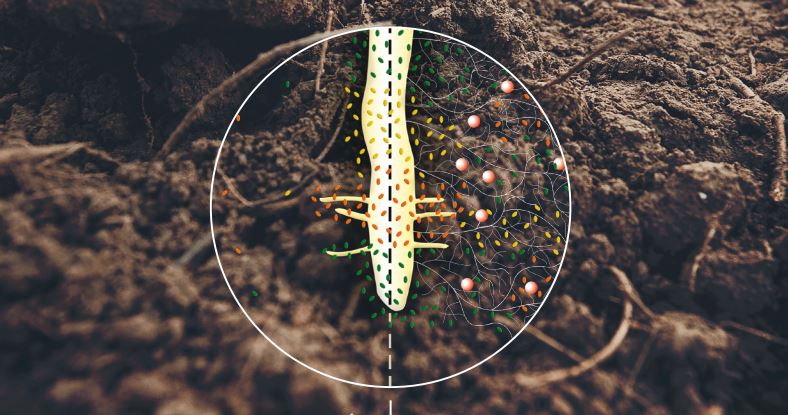Additional growth
As for Conference, the use of MycorDip resulted in significantly 18% more shoot growth in 2020 (see Table 2). Shoot growth in the first four years increased significantly 20% (8.67 instead of 7.24 m/tree). In 2019, gestation and production were significantly higher. However, this was not the case in 2020. Up to that point, gestation was still low. No growth was measured in the first year of 2017, because planting was done late (in May) and as a result, there was almost no growth.
To conclude, MycorDip combined with organic fertilization mainly resulted in higher shoot growth during this period. This additional growth was very welcome, because growth on this piece of land had clearly been low due to the drought in 2018 to 2020. Normally, the additional growth will eventually also lead to higher gestation in this situation.
| Treatment |
Growth 2018 |
Gestation 2018 |
Growth 2019 |
Gestation 2019 |
Production 2019 |
Fruit weight 2019 |
Growth 2020 |
Gestation 2020 |
Production 2020 |
Fruit weight 2020 |
|
(m/tree) |
(number of fruits/tree) |
(m/tree) |
(number of fruits/tree) |
(kg/tree) |
(g/fruit) |
(m/tree) |
(number of fruits/tree) |
(kg/tree) |
(g/fruit) |
| -MycorDip* |
2.46 |
3.8 |
2.50 |
17.8a** |
3.63a |
205 |
2.28a |
13.7 |
3.40 |
248 |
| +MycorDip** |
2.81 |
3.3 |
3.17 |
21.2b |
4.21b |
199 |
2.69b |
14.3 |
3.40 |
2.39 |
|
NS** |
NS |
NS |
S** |
S |
NS |
S |
NS |
NS |
NS |
|
|
|
|
|
|
|
|
|
|
|
| Difference (%) |
14 |
-11 |
27 |
19 |
16 |
-3 |
18 |
4 |
0 |
-4 |
* -MycorDip: fertilized regularly, +MycorDip: fertilized organically (see Table 2)
** NS: not significant, S: significant
Table 2. The Conference experiment
Additional growth can result in more evaporation, a more dry soil and ultimately, to less fruit growth. However, that was hardly the case here: fruits were 3 to 4% smaller, but these differences were not statistically reliable. In the Elstar experiment, the usage of MycorDip combined with organic fertilization also led to significantly more shoot growth (see Table 3). From the first to the third year of growth, there was a total of 25% more shoot growth. Total gestation over the first four years significantly increased by 14% (in the first year, all fruits were thinned out). The production in kg/tree was almost significantly different. Average gestation in the last three years was 21, 30 and 102 fruits/tree respectively, with average fruit weights of 147, 145 and 116 grams/fruit. This means that in this experiment, we found both a positive shoot growth effect as a positive gestation effect, without this being at the expense of the fruit weight. The average mycorrhizal occupancy of the roots was 27% on 20 November 2019 in the Conference experiment. This was also the case in the Elstar experiment (measured on 26 October 2021). No significant effects of the treatments on the mycorrhizal occupancy were found.
The extreme variation in the measurements in samples from the same treatment, was striking. In this case, only very large differences can be demonstrated statistically reliable. On the other hand, these results indicate that mycorrhizas also develop if no injection is done at time of planting.
| Treatment |
Growth 2019-2021 |
Gestation 2020-2022 |
Production 2020-2022 |
Fruit weight 2020-2022 |
|
(m/tree) |
(number of fruits/tree) |
(kg/tree) |
(g/fruit) |
| -MycorDip* |
572a** |
142a |
18.0(a) |
126 |
| +MycorDip** |
7.16b |
163b |
20.4(b) |
125 |
|
S** |
S |
(S)** |
NS** |
|
|
|
|
|
| Difference (%) |
25 |
14 |
14 |
-1 |
* -MycorDip: fertilized regularly, +MycorDip: fertilized organically (see Table 2)
** NS: not significant, S: significant
Table 3. The Elstar experiment
